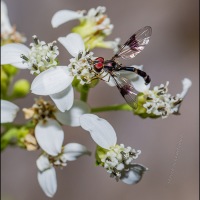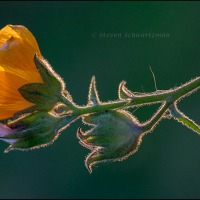Posts Tagged ‘macro’
Two takes on smartweed inflorescences
A visit to Barkley Meadows Park in Del Valle on November 5th yielded two rather different takes on smartweed inflorescences (Persicaria sp.). In the second, a funnel web had covered the smartweed and then fine fogdrops had covered the funnel web.
§
§ § §
§
From the newly released book The Canceling of the American Mind, by Greg Lukianoff and Rikki Schlott, I learned about Ethan Blevins’s opinion piece “Must an Antioch student bow down to ‘social justice’ dogma to graduate?“, which appeared in The Hill on February 6th. Here’s how it begins:
A graduate student at Antioch University in Seattle has incurred the wrath of her college by criticizing their radical approach to training therapists. Leslie Elliott, who says she considers herself a liberal, is a master’s student in clinical therapy. She grew fed up with a department that she believes has abandoned genuine therapy for extreme leftist dogma, and she says Antioch has responded by attempting to defame her and derail her education.
Antioch’s clinical therapy courses taught Elliott that therapists should serve as agents of social change. Race, in particular, should come up quickly in any counseling relationship. The counselor should map clients along a matrix of intersectional identities to determine whether they are “privileged” or “oppressed.” Minority clients should be taught to see how their minority status may have contributed to their problems. If the client is considered privileged, he or she should be taught to confront their white supremacy. In this intimate relationship, where an individual’s unique needs should dominate, counselors reportedly are told to bury the individual beneath the sloppy platitudes of group identities.
The Canceling of the American Mind quoted a later paragraph:
This pattern has become familiar. One wonders whether there’s a manual that college administrators consult when someone stands up to the orthodoxy. The pattern follows the three Ds of illiberal groupthink. First, Deflect: don’t engage the dissenter’s arguments; instead, simply spout hollow buzzwords about the college’s commitment to social justice. Second, Demonize: rather than grapple with the merits of the dissenter’s points, label the dissenter a retrograde racist and declare victory. Third, Dote: express your deep concern for anyone reportedly harmed by the dissenter and promise to repair the wounds of any victims exposed to an alternative viewpoint.
You’re welcome to read the full article.
© 2023 Steven Schwartzman
Rich color on a small scale
If you’ve been coming here for a while you know that colorful fall foliage in Austin occurs mostly on a small scale. One pretty reliable source is poison ivy (Toxicodendron radcans). I found this richly red specimen close to Bull Creek on October 30th.
§
§ § §
§
Three quotations from chapter 2 of On Liberty (1859), by John Stuart Mill (1806–1873)
“If all mankind were of one opinion and only one person of the contrary opinion, there could be no justification for silencing him.”
“The peculiar evil of silencing the expression of opinion is, that it is robbing the human race; posterity as well as the existing generation; those who dissent from the opinion, still more than those who hold it. If the opinion is right, they are deprived of the opportunity of exchanging error for truth: if wrong, they lose, what is almost as great a benefit, the clearer perception and livelier impression of truth, produced by its collision with error.”
“He who knows only his own side of the case knows little of that.”
© 2023 Steven Schwartzman
More from Barkley Meadows Park
Once again from Barkley Meadows Park in Del Valle on November 5th, have a look at this damselfly on the leaf of a young black willow tree (Salix nigra). Many of the sapling’s leaves, including this one, had conspicuous red or reddish galls on them. They appear to be the work of Aculops tetanothrix, known as the willow gall mite. (Compare how the gall mite Aculops rhois creates similar galls on poison ivy.)
And speaking of color, how about the big aquamarine eye on this damselfly? As best I can tell, we’re dealing with the genus Argia, whose members are commonly called dancers.
§
§ § §
§
A few years ago, I worked at a psychotherapy clinic in New York City. A couple of weeks after starting, a therapist of color described his Jewish graduate-student patient in a clinic-wide meeting… This patient had come for help with depression and social anxiety, but he also expressed frustration because he felt he lost out on a research fellowship based on affirmative action. The ethnically diverse group of about two-dozen providers (psychiatrists, social workers, and psychologists) discussed the patient and then came to an apparent consensus: the patient needed to be confronted about his racism and then be told that if he didn’t want to overcome his biases, he would be asked to leave therapy.
They argued it would be “unfair” for a non-white therapist to have to provide therapy to such a racist patient unless he changed his views. No one seemed to consider that it might be unethical to turn a patient away from therapy for his opinions about affirmative action.
Another example: In a case conference at a different clinic, one therapist described a session with a black high school student who was the daughter of African immigrants. This patient reported speaking in one of her classes to say that “all people are the same regardless of race.” In response, her teacher called her “racist” and condemned her views in front of the class.
Those are excerpts from Andrew Hartz’s June 2022 article “Leftist Extremism Is Turning Therapists And Counselors Against Their Own Clients,” which you can read in full.
© 2023 Steven Schwartzman
Return to Barkley Meadows Park

On Monday you saw some three-year-old pictures from Barkley Meadows Park in Del Valle. Preparing that post had put the park in my thoughts, so this past Sunday I drove out there for an updated look around. The morning had come up rather foggy, and I hoped to use that as an atmospheric element. Well, the fog began dissipating almost as soon as I arrived, an instance of a famous observation:
The best-laid schemes o’ mice an’ men
Gang aft agley.
But it’s also been said that every cloud has its silver lining, and the fog left behind a coating of fine dewdrops that not only quickly soaked my shoes as I walked around but also adorned the subjects in some of my closeups. In this downward look at a horizontal portion of a funnel weaver spider‘s web, the dewdrops collectively became the primary subject.
Those of you interested in the craft of photography will find points 1 and 15 in “About My Techniques” relevant to today’s image.
§
§ § §
§
Twenty years ago, when I was a college student, I started writing about a then-nameless, niche ideology that seemed to contradict everything I had been taught since I was a child.
It is possible I would not have perceived the nature of this ideology—or rather, I would have been able to avoid seeing its true nature—had I not been a Jew. But I was. I am. And in noticing the way I had been written out of the equation, I started to notice that it wasn’t just me, but that the whole system rested on an illusion.
What I saw was a worldview that replaced basic ideas of good and evil with a new rubric: the powerless (good) and the powerful (bad). It replaced lots of things. Colorblindness with race-obsession. Ideas with identity. Debate with denunciation. Persuasion with public shaming. The rule of law with the fury of the mob.
People were to be given authority in this new order not in recognition of their gifts, hard work, accomplishments, or contributions to society, but in inverse proportion to the disadvantages their group had suffered, as defined by radical ideologues. According to them, as Jamie Kirchick concisely put it in these pages: “Muslim > gay, Black > female, and everybody > the Jews.”
So began a November 7th article by Bari Weiss in Tablet, “End DEI: It’s not about diversity, equity, or inclusion. It is about arrogating power to a movement that threatens not just Jews—but America itself,” which you’re welcome to read in full.
© 2023 Steven Schwartzman
Miniature amphibian
The green heron I saw along Bull Creek on August 17th was much less familiar to me than the miniature amphibian I saw hopping about in the dry creek bed. These little creatures are only about an inch long.
Similar to amphibian is amphigory (especially if you stress it on the second syllable rather than the first; both are accepted pronunciations). Amphigory is ‘a nonsense verse or composition : a rigmarole with apparent meaning which proves to be meaningless.’ This amphibian produced no amphigory, at least not while I was there to hear it.
❂
❂ ❂ ❂
❂
After teaching math for a year and a half in Honduras as a Peace Corps volunteer, I returned to New York at the end of 1969 and was dismayed to find out that no public high school would hire me as a math teacher because I’d never taken any “professional” education courses. (Oh, how I came to loathe the word “professional,” which bureaucrats wield as a cudgel.) The fact that I’d already taught for a year and a half made no difference. For three years I resisted going back to school, then somehow discovered—remember, the Internet still lay a quarter-century in the future—a program at Duke University that in just 14 months would get me both a Master of Arts in Teaching Mathematics and a secondary school math teaching certificate for North Carolina. That was by far the best deal I could find, so that’s what I did. Half the courses in the program were math, which was fine, because I hadn’t been a math major in college; I particularly liked the introductory number theory class. The other half of the courses were education, and a total waste of my time. I learned nothing of any value in those education courses.
Now here we are fifty years later. Education departments are still a waste of time, but what’s worse is that now they’ve become indoctrination mills for transgressive causes. If you want a glimpse at how noxious the education schools are, read an August 19th Wall Street Journal article called “Education Schools Have Long Been Mediocre. Now They’re Woke Too.” In the article, Daniel Buck describes what he experienced when he studied for a master’s degree in education at the University of Wisconsin-Madison in 2015. For example:
We made Black Lives Matter friendship bracelets. We passed around a popsicle stick to designate whose turn it was to talk while professors compelled us to discuss our life’s traumas. We read poems through the “lenses” of Marxism and critical race theory in preparation for our students doing the same. Our final projects were acrostic poems or ironic rap videos.
In that article Daniel Buck links to a study conducted by the Wisconsin Institute for Law and Liberty, which analyzed syllabi in the education schools at the 14 branches of the University of Wisconsin:
On the syllabi, noticeably lacking are academic literature or manuals of classroom instruction. Instead, Hollywood movies like “Freedom Writers,” popular books like Jonathan Kozol’s “Letters to a Young Teacher,” and propaganda like “Anti-Racist Baby” abound. In place of academic essays, graduate students write personal poems or collect photographs. These kitschy activities infantilize what ought to be a rigorous pursuit of professional competency.
You can find out more distressing details in Daniel Beck’s article and in the report by the Wisconsin Institute for Law and Liberty.
© 2022 Steven Schwartzman
Here’s looking at you, kid
Cicada, Tibicen superba; August 3 in Wells Branch.
❖
❖ ❖ ❖
❖
In a commentary yesterday I said I believe people should report things accurately, without exaggeration. Not long after writing that, I came to the section in Alex Epstein’s book Fossil Future called “The ‘Deliberate Overstatement’ Distortion.” He identifies “four forms of deliberate overstatement that dramatically and negatively distort our knowledge system’s assessment of the climate impacts of rising CO2 levels.”
- Punishment of climate catastrophe skepticism.
- Equation of consensus on some climate impact with consensus on massively negative climate impact (the 97 percent fallacy).
- Deliberately overstated report summaries.
- Deliberate overstatement by designated experts for effect.
Those things are similar to what ideologues do in fields other than climate science. For example, some doctors have urged caution about putting children on puberty blockers and opposite-sex hormones because those drugs produce serious effects that soon become irreversible. Nevertheless, activists attack those cautious doctors, label them “trans-phobes,” and work to get their articles suppressed and get them fired from their jobs.
Similarly, researchers who recognize that the climate is warming yet urge caution in concluding that a warming climate will necessarily be catastrophic or apocalyptic get labeled “climate deniers.” Activists work to cut off funding to those researchers, to get publications to refuse articles by thm, and to get those researchers fired from their positions.
So I say, as always: let everyone bring forth the facts they’ve found, and let’s do our best to draw conclusions by assessing the unadulterated, unexaggerated evidence. I don’t want to live in a world where we only get to hear one side of an argument, and yet that’s the kind of world I increasingly find myself in. I never thought I’d live to see that in the United States.
© 2022 Steven Schwartzman
Clematis drummondii swirls

I never get tired of the swirly strands that fertilized Clematis drummondii flowers produce each summer. Compared to the photographs two days ago, this is an intimate view, showing a span of maybe two inches. The photograph dates back to July 15th in Great Hills Park.
¶
¶ ¶ ¶
¶
As soon as ancient human remains are excavated, archaeologists begin the work of determining a number of traits about the individual, including age, race and gender.
But a new school of thought within archaeology is pushing scientists to think twice about assigning gender to ancient human remains.
It is possible to determine whether a skeleton is from a biological male or female using objective observations based on the size and shape of the bones. Criminal forensic detectives, for example, do it frequently in their line of work.
But gender activists argue scientists cannot know how an ancient individual identified themselves.
That’s the beginning of an article by Christian Schneider in The College Fix headlined “Gender activists push to bar anthropologists from identifying human remains as ‘male’ or ‘female.'” What the article reports on is just one more instance of “the woke” pushing to extend their ideology into the past.
I assume that the phrase “how an ancient individual identified themselves” is Schenider recording how the activists would put it, rather than the standard “how ancient individuals identified themselves.”
You’re welcome to read the full article, which includes this:
San Jose State archaeology Professor Elizabeth Weiss told The Fix that eliminating gender classifications amounts to “ideologically-motivated fudging.” Weiss said there is a move among academics “toward getting all of the academy’s favored shibboleths to accord with one another.”
Weiss said the recent explosion in the number of people identifying as transgender suggests that trend is “social and not biological,” so “retroactively de-sexing obscures this obvious fact.”
© 2022 Steven Schwartzman
Lace cactus
Yesterday I found flowers on several adjacent lace cacti (Echinocereus reichenbachii ssp. reichenbachii) in my hilly northwest part of Austin. Today’s picture of one is the first I’ve ever shown here. Great saturated colors, don’t you think?
❖
❖ ❖ ❖
❖
For decades I’ve criticized the American education system. In the 15 years since I last taught, not only have the old problems persisted and worsened, but new problems have arisen. Here’s how Shane Trotter describes one of them in his Quillette article “Hidden in Plain Sight: Putting Tech Before Teaching.”
In its desire to embrace technology, our school district failed to recognize the social devolution that was taking hold of society. The iPad Initiative [which he’d just described in detail] came right as smartphones became virtually ubiquitous among American teens and adults. Teens began spending over seven hours per day consuming entertainment media. Twelfth-graders in 2015 were going out less often than eight graders Adolescent mental disorders skyrocketed. And at this crucial juncture, we decided to begin allowing students to use smartphones throughout the school day. These students would not know how to set boundaries for how they used their phones. They’d have no understanding of the psychological vulnerabilities that tech companies exploited—no training in how to use their phone without it using them. Most of all, they’d have no environment where they could be free from the incessant psychic drain that had come to define their world. Oblivious to any responsibility to help students or their families adapt better, our schools helped facilitate the community’s descent into becoming screen-addicted, constantly distracted people whose cognitive skills and attention spans were being chipped away rather than cultivated.
You’re welcome to read the full article.
© 2022 Steven Schwartzman
Armed
Buffalo bur (Solanum rostratum) produces heavily armed seed capsules, as this picture from December 16, 2021, in my neighborhood confirms. What the capsules lack in size, they make up for in skin-puncture power.
❡
❡ ❡
❡
…[N]egative information is attention-grabbing—it is literally processed differently in our brains—whereas… progress is mostly gradual and incremental. We’re not nearly as adept at spotting these trends as sudden and eye-catching disasters. Max Roser from the University of Oxford points out that newspapers could legitimately have run the headline ‘Number of people in extreme poverty fell by 137,000 since yesterday’ every day for the last twenty-five years. But, as we’ve seen from academics’ detailed analysis of news values and criteria, the predictable isn’t newsworthy, because that’s how our brains work: we get the media we deserve and, to some extent, crave.
So wrote Bobby Duffy in Why We’re Wrong About Nearly Everything. In addition to reading that book, you’ll find lots of interesting information at the Ipsos website that documents people’s misperceptions about many things. (Professor Duffy used to be the managing director of the Ipsos MORI Social Research Institute and global director of the Ipsos Social Research Institute.)
© 2022 Steven Schwartzman


















